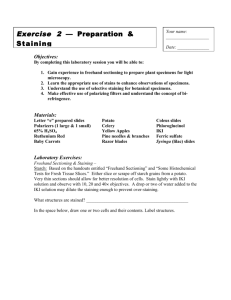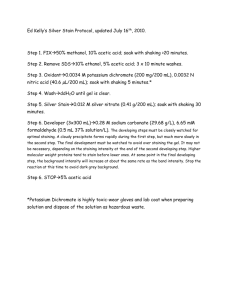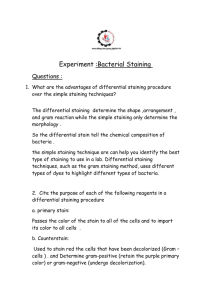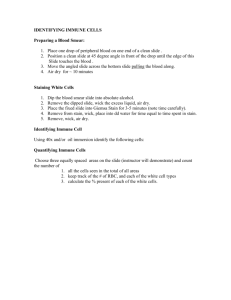practical4 blood film preparation (1)
advertisement
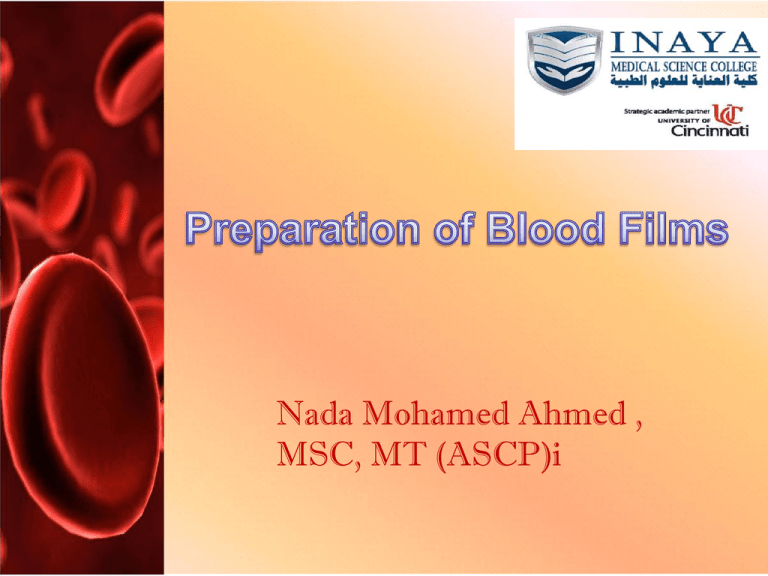
Nada Mohamed Ahmed , MSC, MT (ASCP)i Preparation of Blood Films • • • • • • Values: To study morphology of RBC. To study morphology of WBC. To study morphology of Platelets. To confirm diagnosis of blood cells disorders. To examine hemoparasites(Malaria, Trypanosoma, Babesia) • • • • • • Requirements: 1-Blood Sample: -EDTA ant coagulated (venous whole blood). -Finger prick blood (Capillary blood). 2- Stationary clean slide 3-Spreader slide • Procedure: • Use clean standard size glass slides (3 inch x 1 inch = 7.5 cm x 2.5 cm), wiped from dust just immediately before use. • Place a small drop of well mixed anticoagulated whole blood, in the center line of the slide, about 1.5 to 2 cm from one end, with the aid of a capillary tube. • Immediately, without delay, with the aid of a second clean slide with uniform smooth edges (spreader slide), with a 30 –40 degrees angle, move back so blood drop will spread along the edge of the spreader slide, when this occurs, spread, or smear move forward to make ideal . Thin blood film consist of thick Head, body and tail. • Improper blood film A: Blood film with jagged (with rough, sharp points )tail made from a spreader with achipped end. B: Film which is too thick C: Film which is too long, too wide, uneven thickness and made on a greasy slide. D: A well-made blood film. Examples of unacceptable smears Examples of unacceptable smears • Quality Control for blood film preparation : • 1-Before preparing the films, you must check that blood samples are free from clotsIf clots are present the specimen is not used. • 2-Films can be labeled with patient’s name and /or Lab. No. on the thick end of the film itself, after being dried, by using a pencil. • 3-Thin blood film must be done immediately as long as two to three hours after venous blood collection. • • principle of Romanosky stains • Group of blood cells stains each consists of Azure B (the basic dye stains the acid portion of the cell) and Eosin Y ( the acidic dye stains the basic portion of the cell). • • • • Romanovsky stains include: 1-Giemsa Stain 2-Wright’s Stain 3-Leishman Stain • Leishman Stain: • • • • • • • Requirements Adequate air dried thin film Buffer (PH 8.6) instead pure distilled water. Procedure 1-Put the film on a staining trough rack. 2-Flood the slide with the stain. 3-After 2 minutes ( or more, if the stain in newly prepared), add double volume of buffer or distilled water, and mix the stain with water, until a shiny layer is seen. • 4- After 8 minutes, wash with a stream of tap water. • 5-Wipe the back of the slide with gauze. • 6-Set the films in upright position on a dryer rack then examine macroscopically and microscopically. Romanovsky Stain Blood Cells Characteristics No. Cell Structure Staining characteristics 1 Red cells Red or pinkish red 2 Nuclei of all cell types Purple/violet 3 Lymphocyte cytoplasm Blue 4 Monocyte cytoplasm Grayish blue(or glassy gray) 5 Platelets cytoplasm Light blue 6 Neutrophilic granules Violet-pink 7 Eosinophilic granules Orange-red 8 Basophilic granules Purplish black/ Deep blue 9 Platelets granules Purple Staining characteristics of a correctly stained normal film: Nuclei Purple Cytoplasm Erythrocytes Deep pink Neutrophils Orange-pink Lymphocytes Blue; some small lymphocytes deep blue Monocytes Grey-blue Basophils Blue Granules Neutrophils Fine purple Eosinophils Red-orange Basophils Purple-black Monocytes Fine reddish (azurophil) Platelets Purple Eosinophilic granules Blue nucleus Basophilic granules Staining faults Too faint: Staining time too short. Excessive washing after staining. Stain deposit: Stain solution left inuncovered jar. Stain solution not filtered. Dirty slides. • • • • • • • • • • • • Other factors which affects the staining results include : 1) Staining time, 2) pH of the staining solution, while Sources Of Errors In Staining Stain Precipitate or deposit: May obscure cell details, and may cause confusion with inclusion bodies. Eliminate by use of the stain before use. pH of the buffer or water: Too acidic pH causes too pinkish slides. Too basic pH causes too bluish slides. Improper stain timing may result in faded staining or altered colors: Too long staining time causes too blue slides (overstaining). Too short staining time causes too red slides. Forced drying may alter color intensities and/or distort cell morphology. TOO ACIDIC SUITABLE TOO BASIC • • Non-stain related errors: 1-EDTA causes crenation of the cells after blood collection. • 2-Severely anemic blood samples causes slower drying (before staining) due to excessive plasma. 3-Old blood specimens may cause disintegration in WBC’s and decrease in their numbers. • • 4-Collection of blood in heparin causes blue staining of RBC’s with bluish background, which makes heparin unsatisfactory for routine hematology testing, also heparin induces platelet aggregation and clumping , with subsequent erroneous platelet count with automated counters.

